FergWorld : Travelogues & Photos : 2003

By Ryan Ferguson, © 2001-2005
Click here for 2004-2005 updates » (previous page)
Two checkrides, one day, one helicopter
12/22/03: Earned my helicopter instrument rating and instrument instructor rating. Straightforward checkride with no surprises. Hoo-rah! My first instrument student was lined up as we were finalizing the paperwork. Sublime.
Going back to... Cali
Route:
SFB -> 5M0 -> SWI -> LBB -> GCN -> BUR
BUR -> AEG -> RBD -> BTR -> SFB (return)
Aircraft: Piper PA-30B Twin Comanche
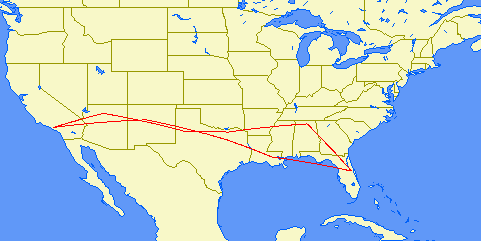
Great circle route courtesy Great Circle Mapper
12/03/03: Back from another transcontinental blitz. Noel accompanied me yet again. Neat weather challenges on the way out - nestled up to a squall line in Alabama, and landed in Hartsell (southwest of Huntsville) to wait out the passage of a cold front. Ground speeds on the GPS approach to runway 36 were... 215 knots! By the time we broke out they were down to 165 knots. Talk about some serious windshear - circling to land on 18, our final approach ground speed was around 60 knots.
We had to work our way back down to the south to avoid more convective activity associated with the front, and by that time we abandoned our plans to overnight in Colorado and settled for New Mexico - or so we thought. As the temperature dropped, it became obvious that the heater was inop. Uh oh. We managed to hold out until SWI, where we refueled, warmed up, and then launched again into the cold night for Albuquerque. After a couple of hundred more miles westbound, it became evident that if we did make to Albuquerque, we'd be transformed into frozen popsicles, so we diverted to the center of the known the universe: Lubbock, Texas. Actually, Lubbock wasn't too bad - hotel rooms were $55 with the Lubbock Aero rate. I was chilled to the bone; think I was still cold 'till the next morning!
The next morning we departed for the Grand Canyon - what a cool fuel stop, although the fuel prices at GCN are unfortunately (and not surprisingly) nearly as steep as the canyon walls. We had time only for microwave-prepared frozen food before launching for Burbank, where I was to spend nearly a week on a business trip. Damn that heater... we were cold the whole way out. I popped the nosecone to troubleshoot, but the overheat relay had not popped, all the CBs and fuses appeared intact, and I had no clue why my nice, new overhauled heater gave me the shoulder. We'd have to fly home that way, too.
Spent a week in L.A. Despite being in good company, I hate that area. No offense to those among you who live there, but I think it's the one of the fruitiest, most bass-ackwards places in the U.S. Being that it's a show-biz town, everything is glitz, glamour, and appearance. Very shallow. When I'd completed my tasks, I was happy to leave for the east coast.
Upon the return trip, Noel and I stopped at Double Eagle II in Albuquerque for a mexican siesta, er, breakfast. We dined at the Prop Wash Cafe above Mesa Aviation. The salsa was nice and hot, as in REALLY hot, the way salsa should be... I was sweating! I asked the cook for a bottle to go, and he swelled with pride as he scurried around to produce a bottle suitable for long distance transport of his valuable concoction.
Another cold leg to Redbird, with good weather this time, another bite at Mickey Ds, then off to Baton Rouge for another fuel stop to be on the safe side. We were getting 180-190 knots groundspeed for most of the return journey; I could have planned the flight better to avoid the extra fuel stop.
All in all, a satisfying journey in which the airplane flew well with no squawks except the heater, which I've since fixed since the return home.
Instrument flying in helicopters
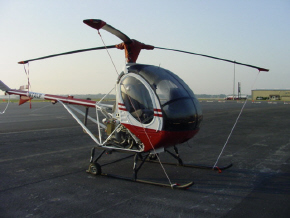 10/10/03: I'm in the midst of my helicopter instrument rating/CFII. I'm flying Air Orlando's beautiful Schweizer 300CBi instrument trainer. This is top-of-the-line equipment - the helicopter features a slaved HSI (electrically powered), Garmin 430, audio panel, the works. It's nearly a brand new machine, no squawks, stable, quiet, smooth. I love flying it.
10/10/03: I'm in the midst of my helicopter instrument rating/CFII. I'm flying Air Orlando's beautiful Schweizer 300CBi instrument trainer. This is top-of-the-line equipment - the helicopter features a slaved HSI (electrically powered), Garmin 430, audio panel, the works. It's nearly a brand new machine, no squawks, stable, quiet, smooth. I love flying it.
This is straightforward stuff. Instrument flying in the helicopter is quite easy insofar as the flying is concerned. CRM is another issue; there's no way to write anything down, and setting up the stack one-handed, racing the throttle slippage is rather challenging. As such it is permissible to use the examiner (or other pilot) to assist in these chores.
Airborne clearances and instructions (missed approach, etc.) must generally be memorized. Luckily they're standard for SFB and ORL; I know what to expect.
There are a few copter-specific instrument issues that must be learned. For example:
- On a conventional standard instrument approach (i.e. not a Copter approach) all minimum visibility requirements can be cut in half; however, RVR 1200 or 1/4 mile vis. (whichever is greater) is the minimum. Conventional SIAPs may be flown at the upper limit of the highest approach category authorized by the procedure, but the visibility minimum reduction only applies if the helicopter is at or below 90KIAS at the missed approach point. Copter approaches must be flown at no more than 90KIAS (on any segment of the approach), and no visibility reduction is allowed.
- Rules for when an alternate must be filed are different than in airplanes; at the time of estimated arrival and plus (+) 1 hour, ceilings must be 1000 ft. or 400 ft. above the lowest applicable approach minima, and visibility must be at least 2 statute miles. (So much for the easy to remember 1-2-3 rule... )
- Remember 600-2 and 800-2 for alternate minimums? It's not the same in helicopters... the ceiling must be 200 ft. above the approach to be flown, and visibility must be at least 1 statute mile (but never less than the minimum visibility for the approach to be flown.)
- There are some specific approach speed maximums on GPS Copter approaches. 90KIAS on any segment is the maximum, EXCEPT limited to no more than 70KIAS on the final and missed approach segments.
- IFR fuel minimums for helicopters: you must be able to fly to your destination airport, then to the alternate if one is required, and then for 30 minutes thereafter at 'normal cruising speed.'
I'll be taking both the instrument and instrument instructor rides on the same day. And at long last, I should be done with my instructor ratings!
Hired
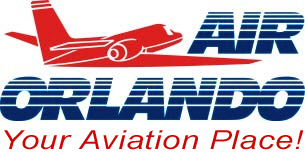 9/10/03: I am pleased and very proud to announce my affiliation with Air Orlando, located at the Orlando Executive airport.
9/10/03: I am pleased and very proud to announce my affiliation with Air Orlando, located at the Orlando Executive airport.
4 years, 12 checkrides, and 1300 hours after my first flight at Air Orlando, I am finally a member of the team for which I've held such respect and admiration.
Air Orlando has the biggest and best-maintained fleet of aircraft, the finest instructors, and the most professional and safety-oriented attitude of any fight training school or academy I've seen. Perhaps equally important is the company's commitment to customer satisfaction, and making the process of learning to fly or achieving advanced ratings an enjoyable one.
I'm passionate about flying and instructing others to fly; so this is a perfect match for me.
If you're in the Orlando area and are looking for an instructor or a place to fly - contact me either via email or by calling Air Orlando at (407)896-0721. I'd be thrilled to hear from you!
ATP
9/08/03: My office includes a new pile of books and study materials. They seem to have an internal vibration, radiation, whatever - they suck the life out of the room and the pile sits like a monument demanding attention. They're sitting there because it's time to start getting serious about the ATP (Airline Transport Pilot) certificate. The ATP is the 'doctorate' of aviation, a serious endeavour requiring much study and pilot proficiency. There is no higher certificate or rating awarded by the FAA, but to keep things in perspective, it is still simply just a piece of paper, albeit a very important one for a pilot who hopes to make a career out of aviation.
Just adequately knocking out the ATP written is going to take awhile - the written test prep book and test question bank are quite large. And I still don't meet all the requirements to be granted an ATP certificate; I'm 200 hours short. However, 200 hours is not that much of a stretch for a flight instructor, so it's not inconceivable that I'll be taking the ATP checkride as early as January of 2004. We'll see!
Night flight
8/01/03:
Late night flight last night, coming home to Orlando-Sanford from Ft. Lauderdale Int'l. Sitting on the ramp at about 11pm local, waiting for a 737 to depart in front of me, I heard this exchange:
"Delta 26, Ft. Lauderdale tower, return to the gate for a passenger identification."
They must have not have been back too far on the push because about 30 seconds later, I heard: "We're at the gate."
"Delta 26, have your flight attendant check twenty-two foxtrot."
This controller was working local, ground, and clearance by himself, and after a couple of inbound calls to which he did not respond, he told everyone to stand by.
"Delta 26, Lauderdale tower, ready to copy?"
"Go ahead."
"O-S-M-A-N." Then tower read the letters off phonetically. I sat in the cockpit riveted by the exchange.
"Police are coming. Passenger should remain seated."
About 15 seconds later, Delta 26 radios back "Roger, we're familiar with this guy from JFK. We understand the passenger should remain seated. What about the other passengers?"
"26, tower, try to keep them seated."
"Delta 26, roger - some are out of their seats."
Another few seconds went by. Tower called again: "Delta 26, feds are coming too."
"26."
More time goes by. No one seemed to mind sitting around waiting for departure, because this was a heck of an interesting exchange.
Tower then cleared the 737 ahead of me for takeoff. As the jet was rolling, tower called to check in: "How are things looking, 26?"
"Tower, we got the call a little late and we can't fully secure the cabin."
"Roger. Feds on the way."
"The passenger is seated," 26 called back.
"Roger."
Then I was cleared for takeoff. Never heard what happened past that point.
Things that make you go, "Hmmm... "
On the way home, I enjoyed the calm night air and beautiful view. As I was handed off to Orlando approach, I noticed the frequency was rather quiet, so I considered asking for a T&G at MCO. In the 4 years I've been flying in Orlando, I've never landed at Orlando International airport - they're just too busy for GA aircraft to shoot practice approaches most of the time. I queried the controller and he said he'd be happy to give me a visual or an ILS. I took the ILS. I got vectored around quite a bit, and had to box around to the right once to let an MD-11 get around me, but I did get to touch down at MCO finally.
CFII checkride passed!
7/25/03: Whew... I added an instrument airplane rating onto my Flight Instructor certificate this morning after passing DPE John Azma's practical exam. Always a pleasure to fly with this guy. Highly recommended as a DPE.
Flew a GPS approach as part of the flight test... man, those are cake if you can work the box correctly. Once it's set up it's almost foolproof. Definitely my non-precision approach of choice if it's available.
I hope to begin studying soon for the helicopter instrument rating and associated instrument helicopter rating on my Flight Instructor certificate.
Instrument proficiency
7/22/03: I think I'm at my peak with instrument proficiency right now. Of course, that is to be expected considering my CFII checkride is scheduled for this coming Friday.
Flying with Noel, we steadily ratcheted up the pressure until we flew partial panel single-VOR intersection holds and partial panel (and single-engine) ILS approaches with glideslope failure outside the OM -- without breaking a sweat. I can even rattle off all of the visual references of the runway environment as defined by 91.175 (probably should've known that before), tell you the course width of a localizer and height of a glideslope in degrees and... ta-da! I can decode the nastiest text radar summary you can throw at me. Of course, at least some of that stuff I'll forget, but everytime I relearn this stuff more of it tends to stick.
Hopefully my next entry will be 'CFII checkride passed!'
Helicopter instructor checkride passed
7/07/03: Another one bites the dust - passed my rotorcraft-helicopter flight instructor practical test today. My autorotations all went very smoothly and I felt that I flew well. It sure is a relief to have that one done. I'm already making plans to jump back into the airplane CFII with my friend Noel.
Proficiency
7/04/03: I woke up this morning thinking about tail rotor failures. It was a fitful sleep - trying to remember all the various failure modes and recoveries (there are four of them, all distinctly different, based on where and when the failure occurs and which direction the nose of the helicopter yaws.)
With my helicopter flight instructor flight test looming very, very near now, I look back on what I've learned from helicopters so far. Clearly, gaining instructional competency in the flingwing has required the most proficiency and concentration, moreso than any other flying I've done, by a wide margin. I feel confident in my ability to safely instruct in this machine, but it requires a mental 'edge' and toughness which I never felt I needed to cultivate in the airplane. Airplanes more or less fly themselves. They feature few phases of flight which are truly crucial, and that's true even of more complicated and advanced airplanes. Every second of every instructional flight in the helicopter requires this edge, and truth be told, this challenge is what drives me to absolutely love flying rotorcraft. I absolutely, positively, LOVE the fact that it's as challenging as it is. But at the same time, I have a lot of respect for what this job will require from me. I am glad I have more experienced rotor instructors around me so that I can continue learning - there's still so much to take in. The road ahead simultaneously daunts me, and tickles me pink.
Toilet milestone!
Aircraft: Twin Beech 18H
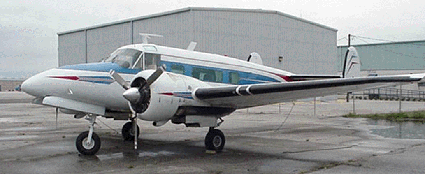
Picture courtesy Larry Tague, airplane4sale.com.
6/07/03: Thanks to Larry Tague for letting me fly N6000M, a Twin Beech nosewheel conversion (called an 18H.) It's the first airplane I've flown with a toilet, a set of stairs, and an entry procedure that requires walking through a voluminous cabin. It's powered by two Pratt & Whitney R-985-AN-14B 450 HP injected radial engines, features complete deice, cabin O2, a fantastic panel and... no smoking and fasten seatbelts lights!
All things considered it was a pretty easy airplane to fly, although I might need some coaching to get the engines started if I flew it again. The dual Garmins (530/430) displayed traffic and stormscope data. We cut an engine in cruise and I was surprised at how little rudder pressure was need to maintain straight and level flight. It was really quite benign.
Have a look at these pictures...
Cross-country in a Turbo Twin Comanche
Route:
ROA -> SUS -> GCK -> PUB -> PUC -> RNO -> O31
Aircraft: Piper PA-30B Turbo Twin Comanche
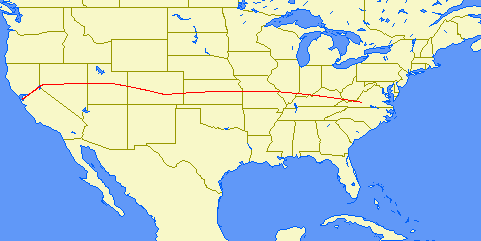
Great circle route courtesy Great Circle Mapper
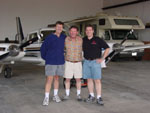
Tom, Skip, and Ryan in front of the Turbo TwinCo, after arrival into Cali. Skip looks a little peaked because I ran him ragged on day 2. |
5/23/03: I had the privilege of accompanying Skip and Tom on the delivery flight of their new Turbo Twin Comanche from Roanoke, Virginia, to Northern California. This was a nicely equipped Twinco; weather radar, a Sandel EHSI, remote compass, Garmin 430, tip tanks, turbochargers (obviously), factory O2, and even an RMI!
We spent two days making the trip, and the owners became more confident and comfortable in their airplane as the hours wore on. We departed into IMC at Roanoke after a very thorough preflight inspection, but were treated to clear weather for the remainder of the trip west of Kentucky.
I always enjoy crossing the Rockies and this trip was no exception. Skip got some high-density altitude experience in his airplane, and Tom and I got to enjoy the scenery. Crossing VFR through the mountain passes is always breathtaking! Those turbochargers sure are nice. The GPS mysteriously 'failed' along the way (one of my favorite jobs as an instructor is breaking things!) and we discussed various equipment malfunctions to pass the time.
We wrapped up with some short-field instruction at the airplane's new home base and called it a wrap. Enjoy the pictures!
Pics
Helicopter commercial add-on flight test passed
5/11/03: Passed my commercial heli add-on flight test today. My autos were some of the nicest to date. Overall, I felt I flew very well. The oral was a breeze.
So now for the real challenge: helicopter CFI.
Helicopter commercial
4/22/03: After cranking into the CFII right after knocking out the initial CFI and then MEI, I hit the 'wall' and had to take a break from airplanes. I also recently took another Florida to Arizona trip (no details or pics this time) which was uneventful except for the extreme time it took to get out to Arizona fighting the westerlies. I think next time I go, I'll do it VFR and stay low going out, and get a better look at the country I'm flying over.
So now I'm back to work on my commercial helicopter add-on. This involves more advanced autorotation work, tighter tolerances, and more pilot smoothness on the controls - much like the commercial ticket for airplanes.
It's a nice break to focus on 'stick and anti-torque' skills (sorry, lame joke) vs. instrument proficiency, at least for awhile. I really have no desire to stare at gauges right now. :)
My current plan is to wrap up the helicopter commercial add-on in short order and take that rotary currency and proficiency right into the helicopter CFI. In fact I have already been flying the Schweizer from the left seat in preparation for this. I found the transition pretty easy, but the downside is that now I'm sitting on the same side of the helicopter as the fuel tank. Since I'm not exactly light, and Gabi is, this means the helcopter is left-skid heavy, but we're still within the lateral CG limits.
As soon as I finish the helicopter CFI I'll go for the airplane CFII, then snag helicopter instrument followed by helicopter CFII. This way I'll have the greatest benefit from recent experience in these two very different types of flying machines, and my instrument knowledge should be quite strong -- assuming, again, that I don't burn out somewhere in there. The idea of accelerating ratings like these over the course of months seems like it'd be staggeringly difficult, at least for me. It's hard enough working full-time and doing this part-time as it is!
So anyay, that's the update from Fort Ferguson. Thanks for reading and please keep sending those emails (in fact, emails asking me why I hadn't updated the site in a month were the main reason for writing this entry!) Take care and be safe.
Best approach ever!
3/9/03: Okay, so I already wrote a 'worst approach ever' entry in my travelogues, but how about 'Best Approach Ever?' Coming back from North Carolina late Sunday evening, widespread IFR conditions developed around north and central Florida due to low-level ground fog. I heard a couple of airliners miss out of JAX due to ceilings of 'VV000' and RVRs as low as 2400 feet. Pretty surreal - from 8,000 feet I could look down and see the perfect outline of JAX's runway 7/25, but the lights were blurred due to the fog. Antennae and objects were sticking up out of the mist. I watched an airplane approach and miss - how frustrating! They must have lost flight visibility entering that oh-so-shallow layer.
Things were only slightly better at Sanford, where the tower had closed and AWOS was giving up to the minute(ish) weather. The first time I tuned in, they were reporting 200 feet overcast and 1 1/2; 10 minutes later it was down to 1, then 3/4 by the time we were being vectored in.
Discover Air (of ATA fame!) shot the approach in front of us. We were dismayed to hear them on the miss as we flew downwind. It was late and we all wanted to get home. Daytona was a suitable alternate, reporting a 300 foot overcast, but that would mean hours of hassle and delays in getting home.
A small beacon of hope: "By the way, approach, Discover wants to try again - we think the lights were not up all the way." We were cleared for the ILS and down we went... passed into the murk at about 1700 feet. Looks like my practice paid off because we nailed the ILS most of the way down - was just slightly high on the glideslope on the initial portion of the approach because I was still configuring the airplane. I flew the approach at 120 mph, slower than my normal preference, and counted down to our decision heigh of 255' MSL. "Out of 400 for 255... 300 for 255... " RIGHT at minimums we saw the rabbit. Down another 100 feet. The runway environment came into view and we landed uneventfully. Woo-hoo! Nothing better than a down-to-the-wire ILS. I love it.
We taxied clear and radioed to approach that we were canceling IFR, then waited for Discover to try again. We were rewarded with a very impressive sight indeed: the airplane breaking out right at minimums, seemingly appearing from thin air just a few hundred feet out from the runway threshold.
Did I ever mention that flying is cool?
To SoCal and back
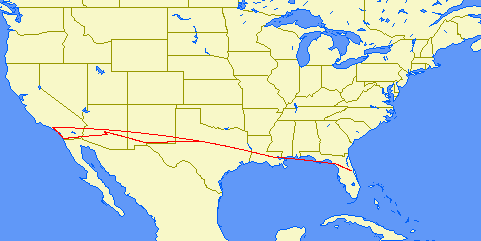
Great circle route courtesy Great Circle Mapper
3/04/03: Noel and I made another marathon journey, this time from Florida all the way to left coast. We departed early into heavy headwinds and were forced to stop just 100nm into our journey at Cross City. A line of embedded thunderstorms was coming through, so we nudged up as close as we felt we could get, then waited it out. We had good hospitality but unfortunately the 'new' FBO is under construction at CTY and we had to wait in an abandoned, leaking structure with no facilities other than bathrooms.
Finally we got along on our way and slogged slowly westward, leaving the precip and IMC behind as we departed Baton Rouge for our third leg. I believe our average ground speed was probably around 115 knots. SLOW. By the time we landed in Las Cruces, New Mexico, Noel and I were swapping off for power catnaps in order to keep going. We got into Phoenix at about 6 AM local, which works out to nearly 20 hours of travelling time from the time we departed Sanford (although a great deal of that was spent on the ground at Cross City, about 4 hours, plus our various fuel stops.)
Two days resting (and for me, working) in Phoenix, including rides in Extra 300Ls at Fighter Combat Int'l at the Williams Gateway, refreshed us for the final short leg to Montgomery Field in San Diego. I was able to take care of several clients in San Diego, and then make two separate sub-flights, one to John Wayne (SNA) and one to Van Nuys (VNY), basing at Montgomery Field while in SoCal. Talk about some complicated airspace! I met with my good friend Tracy Reed while in SD. He was surprised I had spent so much time in the clouds while in his fair city. A storm system had moved in, dumping an uncommon amount of precipitation, leaving low cloud bases and lots of IMC.
The return visit was supremely enjoyable if not uneventful. I was hoping to get a payback for our contribution to the 'headwind kitty' and we were rewarded, as expected, with nice tailwinds due to the prevailing westerlies. Our groundspeed was in excess of 200 knots most of the way. We climbed up to 15,000 feet to maximize the tailwinds and enjoyed a 5.5 hour leg, sipping fuel at just 12 gallons per hour. We made it all the way to Abilene, Texas, in one leg... a great circle leg of 884nm, and with vectors and all of the usual little odds and ends involved in flying over such a long distance, I figure it was probably over 900nm easily. We landed with 1.5 hours of fuel on board! I was tempted to push on another 50nm or 100nm to really 'set the record' (this was my longest single leg distance yet flown) but there were not many good alternatives to Abilene further easy, so we decided to land. Still, I was quite pleased with that figure!
Baton Rouge was again our last stop and we cruised in IMC to reach Sanford, Florida. Yup, sure enough, ceilings JUST BELOW MCO Approach's MVA: bases at 1700 feet. On top of that, Sanford tower was closed and they left the ILS for 27 running, which meant a long vector around the northside of the airport to get to the final approach course. Talk about much ado for nothing... as soon as we descended out of 1700 feet, there was the airport. Total travel time having left San Diego that morning: 13 HOURS! From the left coast to the right coast, in a normally aspirated piston airplane, in 13 hours. Gotta love it.
I don't believe we took too many pictures on this trip. I have a couple, might upload them - didn't have the time or inclination to take too many on this journey.
ATA shuts down
03/03/03: The Central Florida flight training community is still in a state of shock after the closure of ATA, 'Airline Training Academy,' headquartered in Orlando with a remote campus in Arlington, Texas. To the best of my knowledge over 300 students and instructors were locked out with no warning at day's end on Friday, February 28. It has also been related to me that the school's owners, Jim and Scott Williams, have left town. Their lawyers are dealing with the resulting mess. What's particularly heartbreaking about this situation is that many academy students pre-paid for their training with personal funds or outside loans, while others used Key loans to pay for their training. The loans range from $25k-$60k plus and the outlook for those funds being returned to the students is pretty grim. Allegedly, new student enrollment was still taking place mere days before the closure. Bankruptcy is a very real possibility for some of these poor souls who poured everything they had into their new career. ATA is... was an operation which accepted payment up-front for all or some of the customer's training. This tactic immediately removed the burden of proving themselves worthy of their fee on an ongoing basis. The hapless students are left with nothing, or in some cases, partial training received for full payment rendered. Rough stuff.
Why am I posting about this on my website? Because an average of 40-50 people per day read these pages, and a fair number of you are future professional pilots who are either in the process of a career change or contemplating the switch. It's a big investment of time and money, but there are both good and not so good ways to go when it comes to procuring professional, high-quality flight training.
I am unequivocally opposed to the concept of demanding up-front payment for flight training. You're the customer; you judge the quality of the product with your dollars, or your feet. If you're unsatisfied with the quality of your training, you should be free to go elsewhere at any time. Never should you allow yourself to become a slave to the flight school at which you're training. Remember: as long as your money's in your pocket, you have leverage. As long as your money's in their pocket, they have leverage. It seems to me, and others with whom I have discussed this topic and are familiar with the training landscape here in Central Florida, that many students show up for a sales pitch at a Pt. 141 Aviation Academy, are dazzled by the possibility of a turbine job in under a year or 18 months, and fork over their dough not realizing there are other alternatives. That's why I'm writing these words now: there most certainly are other, and in my opinion, better, options.
On the topic of Pt. 141 vs. regular old pt. 61 flight training. Many 141-oriented flight schools offer a pt. 61 equivalent to training which is generally kept in the background and mentioned only as a side-note to the 141 product. Accelerated training has been somewhat of a fad as of late; the student is tantalized with a fast path to the right seat of a turboprop or regional jet, sometimes with purported bridge programs or 'guaranteed interviews' with the airlines. As someone who has met and talked about these programs with quite a few students and flight-instructor/former customers who were at one point sold on them, let me be the first to say that this should be regarded as a fallacy. Ask yourself: in today's troubled aviation market, exactly where is the need for low-time commercial pilots? Thousands of experienced, qualified, and typed pilots are on the market, willing to give up their seniority for a position, any position, with any airline, regional, corporate, or fractional operator interested in hiring them. That puts low-time accelerated training grads on the very bottom of the ladder. Getting ratings fast isn't as important as building quality hours. The 'fast path' is not really any faster, and it's definitely not any cheaper.
"But I can get my ratings with less hours," you say. Yes, you can, but how many people actually do? Take a look sometime at the Pt. 61 vs. Pt. 141 requirements, then add up the fee you'll pay at an accelerated training academy vs. pt. 61, and be sure to compare the number of hours you'll actually end up with at both. I think it's safe to say that in virtually all of the Pt. 61 vs. Pt. 141 examples, if you compare the two accurately, you'll come out much further ahead in hours, experience, and hireability than the 141 grad. And that's assuming that the 141 grad even accomplishes their ratings with less time! Few do, and some take far longer and spend much more than what I consider to be a reasonable amount on training. By the time a pilot is working on his or her flight instructor certificate, he/she should be familiar with average rental and dual instruction rates. I spent about $1,600 on my CFI - $450 of that was on the practical test! Someone I'm familiar with at a large Central Florida Pt. 141 flight school spent over $15,000 getting the same ticket. That's seriously abnormal, and anyone willing to pay that kind of fee needs to do an assessment of what they're getting for the price they pay.
There are a lot of ways to reduce the cost of training, and at some point I might write an article on how to save hundreds or even thousands of dollars on flight training having gone through the ringer myself and learning by trial and error. But what I would emphasize above all else is the need to research flight schools in your area, give serious consideration to Pt. 61 operations, and above all, do not pre-pay for training. An exception to that rule would be block rental rates, i.e. discounts for 10-hour paid-in-cash blocks to rent aircraft. There's nothing wrong with doing so, and at worst you should only be at risk for hundreds of dollars at a time, not tens of thousands.
For more information on this subject, or if you'd like to share your thoughts, please email me at ryan@fergworld.com and I'd be happy to provide whatever insight I can. Best of luck to the ATA folks who are going through some tough times right now.
Back to akro!
02/15/03: ... even if only for a brief, shining moment.
Got to play around with a Pitts S-2E today. An absolutely beautiful little ship, essentially an S-2A which was built as a kit, then returned to the factory (Aviat) where it was completely rebuilt from the ground up in 1999.
I reintroduced myself to loops, rolls, hammerheads, and spins. I'm pretty rough around the edges but the core memory is in there (deep in there) somewhere. Man, what fun.
Two landings, both uneventful. Really not much different than my old S-2C to land, but with a two-bladed prop and 40 less horses. This one is 1/3 the cost and for sale, though... uh oh!
Another brick in the wall
02/09/03: Two 2-hour IFR sessions today. A front stalled out over central Florida, providing absolutely perfect IFR training weather. Ceilings variable between 300 and 600 feet, tops to 10,500, light to moderate precip, nice and smooth with only occasional light to moderate chop. I didn't need to don the foggles once, and my 4 hours of flight time logged include 3.5 of actual. Thank yew, thank yew.
My first session was still oriented around shaking off the rust and getting used to flying instruments from the right seat. Noel's slowly getting me to recall those 5 Ts, whatever the heck they are (grin), and to get procedures a little more standardized at the FAF. More holds and a DME arc to the VOR-DME A at Kissimmee. The arc went well - they're not very hard to fly, but it was still nice to fly a good one. I liked that approach except for the fact that I flew it too fast and spent too long getting down. Noel and I have been taking notes on specific power settings for various approach scenarios and I believe I will be revising my power setting table which I reference in my article 'Flying the Twin Comanche.' Anyway, we broke out right at minimums, gawked at the field for a moment, then zoomed back up into the murk. Two more ILS', both of which were poor in my opinion, but the second ILS showed improvement. Low level northerly winds picked up markedly at 1500 feet and below, a marked contrast to the southerly winds aloft at 15 knots. This caused me consternation on both of the two easterly approaches (runways 9 and 7) I flew, but smaller control pressures, a lighter touch on the yoke, and better trim techniques resulted in a tolerable ILS 9L at SFB. We broke out at 350-400 MSL (I saw the rabbit at 400, then it disappeared and re-appeared at 350.)
Session two, later in the afternoon, was with my good friend Mike, an ERAU geek and CFII. Mike hadn't flown instruments in a number of months, but watching him fly you'd never guess it. He hopped in an unfamiliar twin, departed with me into low IFR, and flew like a pro. Very, very smooth on the controls and exhibited excellent situational awareness. I'm usually all thumbs when I get in an unfamiliar airplane. More intersection and NDB holds (albeit with an IFR GPS, which with OBS mode essentially turns it into a VOR hold), followed by the ILS to Sanford (again) and Exec (again). Aha, now we are getting somewhere! Much smaller excursions off the localizer and glideslope. Donut-land, I am coming home. I hope my next session puts me where I want to be precision-wise with my right-seat flying.
We wrapped things up with Mike flying the RNAV (GPS) 9L into SFB. I set the approach up on the box and left the hard part to Mike. Piece of cake. At 480' MSL we broke out just under the 500 foot broken layer (ATIS was reporting a 600 foot broken layer) and zipped on in to land.
Getting closer by the day!
Instruments with a Vengeance
02/07/03: It's interesting what the training environment can teach you that the real world can't, and vice-versa. Flexing my instrument rating for the past 1.75 years, I had grown accustomed to long-range flight planning, weather strategy, low IFR conditions, missing for real, and dealing with in-flight incidents and even emergencies. (Although I doubt one ever becomes accustomed to emergencies!) But one thing's for sure: cross country IFR happens at a slower pace. It's easier. Equipment tends to work, most of the time. And more often than not, the weather's good, and diverting is a relative rarity, at least here in the southeast.
So. I'm working on my CFII. Back, headlong, into instruments, including all the arcane bits of knowledge I had to learn once and then left to rot. VOR service volumes; how thick is the glideslope in degrees; rattle off the compulsory reporting points for radar and non-radar; recount the ambient, dry, and moist adiabatic lapse rates; the maximum holding airspeeds; the frequency band used by NDBs; and oh, the list goes on. With $40 worth of new knowledge test and oral prep materials, I spent two days re-learning a lot of that old stuff. Then it was time to shake the rust off of my flying skills. Friday night, Noel graciously agreed to occupy the left seat, keep me honest, critique my flying, and ideally prevent us from smashing into obstructions or aircraft. We launched into the clag for 2.2 hours of solid IFR work. Back to fundamentals.
We launched into a broken 1500 foot ceiling, tops at around 3000, with a higher overcast at 6000. Easy. I'd never flown the Twinky on instruments from the right seat. Tonight was the introduction. Getting used to the scan wasn't terribly difficult, but holding my heading was a little harder due to parallax. In the Seneca, I had become accustomed to a 5 degree offset between the heading bug and lubber line, but for some reason in the Twin Comanche the offset is exactly zero. When the line snuggles into the heading bug cleft, despite the parallax, you're right on heading. As such there was a lot of flying slightly off course, especially on approaches and tracking radials.
We decided in our brief to request a hold at MAMBO, which is 20DME on the ORL R-309. Then, the GPS Runway 31 at Leesburg. We'd miss out of there, fly back to Sanford and hold over the NDB (preferably as published,) followed by two ILS approaches. I'd hoped to get a full procedure on one, and a 'glideslope failure' on the other, but it didn't quite work out that way.
Noel started off by reminding me that reporting established in the hold, I'd need to state both time and altitude. I had mentally prepared to slow down within 3 minutes of arriving at the fix, but of course I neglected that until 4 miles out as well. Next I attempted to correct for a wind which I thought was blowing me west of course, but apparently was directly off the nose outbound (and off the tail inbound). Next he reminded me to start the outbound time abeam the fix, not wings level (unless the fix is already behind the wing after the turn is complete.) Oh yeah, now I remember that! After 3 loops I finally got the timing and heading right. My raw flying from the right seat was decent, holding altitude and headings fairly well, although I kept turning the trim crank on the ceiling of the cabin the wrong way since I was sitting on the opposite side of it. (Those of you who've flown a Twin Comanche from both sides will know what I mean.)
Once I was satisfied that I could fly an acceptable DME hold, we continued northwest to Leesburg where we were up for the GPS Runway 31 approach. First bout of confusion: the controller asked us if we wanted to head directly to the Leesburg NDB for the 'full GPS approach.' I frowned, thinking something wasn't right about this, but we were still flipping to the applicable plate when the clearance came through. Since we were still 15 miles out I accepted the clearance and then checked the plate more closely. Of course this wouldn't work, since the NDB plays no role in the GPS approach! In fact, it's not even charted on the plate. We cleared it up by requesting vectors to JELTT, the southwest IAF. The controller didn't have JELTT depicted on his radar screen, so he cleared us direct JELTT, cleared for the GPS 31 approach. Missed approach would be heading 070 and maintain 2000.
I had been wearing a hood for a portion of the flight up to this point, but since we were pretty solidly in IMC and the daylight had all but faded I dumped them in favor of the grey curtains outside the airplane. I'll be darned if we didn't end up flying this approach down to a ceiling of approximately 1,000 feet. Apparently the ceilings were dropping despite the forecast.
We reconfigured the aircraft, flew the missed uneventfully and checked back in with approach. We zipped back to SFB with a nice tailwind and entered the hold depicted on the ILS 9L plate and held as published. This hold went a little better, but that's probably because I allowed myself to cheat this time by looking at my GPS ground track. Boy, that sure makes things a heck of a lot easier, but I'm not going to get used to having it available. It was at this point I realized that despite my recent compass swing I am still getting some oddball indications on certain headings. Westbound, the damn thing was 20 degrees off, but all of the other cardinal headings appeared to be nearly right on. This compass has been giving me fits for the last few hundred hours I've had it, and I'm about ready to simply ditch it and replace it with something new.
Okay, now a vanilla ILS approach. Checking the ATIS, the ceilings had dipped down to 900 feet. We were vectored out, as Orlando approach always does, to the north, then taken on a long left downwind. This controller was a bit harried and gave us a slightly tight turn-in on the first approach, but nothing unmanageable.
What a crappy approach! I had nearly full deflection in both directions and stayed about a dot high on the glideslope most of the way down. The only good thing about this approach was that I found that 19" was doing a much better job of keeping me established on a 500 foot per minute rate of descent at 140 miles per hour than my old 18" setting. Good to know. We broke out at 900 feet coming back in at a 10 degree correction angle to the runway. Eesh, I can fly better than this.
For the second approach, the same busy controller gave us a much-too-tight turn-in which flew us across the localizer just outside the marker. I was able to correct and stabilize the approach from the marker to within 5 miles of the airport. I reached up to turn the trim crank, realized I'd turned the wrong way, and corrected it. About 4 seconds later I looked down and saw myself in a steady 10 degree bank to the right, and I was already nearly 15 degrees off-course! Just like that, I had blown it. I was able to salvage the approach and make it much prettier than the first, but it still will take work to fly like I can with the six-pack in front of me. I like seeing needles centered in the donut on an ILS. This time we broke out at 700 feet (650 AGL). The ceilings were definitely coming down.
My only real treat: a nice crosswind squeaker, with the downwind main remaining clear of the pavement for a good second or two before coming to rest. My reward, though, was shaking off rust and getting comfortable flying my airplane from the right seat on instruments. All in all, a great evening of training, and I'm looking forward to upping my performance a notch on Sunday morning when we go out to do it all over again.
Multiengine instructor
02/04/03: And whaddya know, now I'm an MEI.
Columbia
02/01/03: May the crew of the orbiter Columbia rest in peace.
'As Flight Instructor'
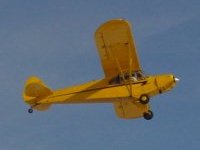 01/28/03: New column with logged hours in my "Jeppesen Professional Pilot" logbook: 'As Flight Instructor.' My younger sister's boyfriend, Ray Forrester, has now logged 2.7 hours in a Piper Super Cub with me as his instructor. Pictures of his flights can be seen below.
01/28/03: New column with logged hours in my "Jeppesen Professional Pilot" logbook: 'As Flight Instructor.' My younger sister's boyfriend, Ray Forrester, has now logged 2.7 hours in a Piper Super Cub with me as his instructor. Pictures of his flights can be seen below.
I'm happy to report that my first student was an easy break-in for a new instructor. Ray took to the controls quickly and flew the plane well. He will have no problem when he begins his training in earnest in Gainesville. I warned him, though, that he might be surprised at the difference between the Cub and the average Piper Archer or Cessna 172!
The Cub is a good plane in which to build the foundation which forms a pilot's repertoire. There are no gyros, little instrumentation, and a nice view out the front and sides. The pilot tends to spend more time looking outside of the cockpit in an airplane like this one, which is the way a student ought to learn. In any case, I know Ray had at least as much fun as I did.
Slow motion rotor video
01/14/03: I've kept an eye out for this video for some time, and stumbled upon it today. As far as I know it is in the public domain (otherwise, if you're the owner, please contact me.) Via a camera mounted on the rotor hub, this video shows an individual helicopter rotor blade as it travels through the slipstream. Amazing to watch.
Thanks to Doedo Schipper for the translation:
"The rotortips absorb the turbulence with their flexibility. This recording was made, during flight, by a camera mounted to the leading edge of the rotorblade. At every turn you can see the tailrotor. If the flexible rotorblades wouldn't absorb the the forces, they would be transmitted to drive mechanism and fuselage and the vibration would destroy the helicopter."
Click here for 2002 updates » (cont'd)
|

